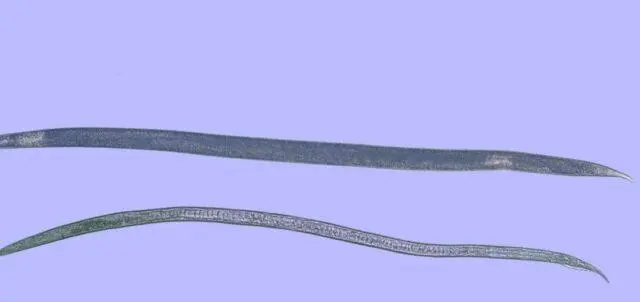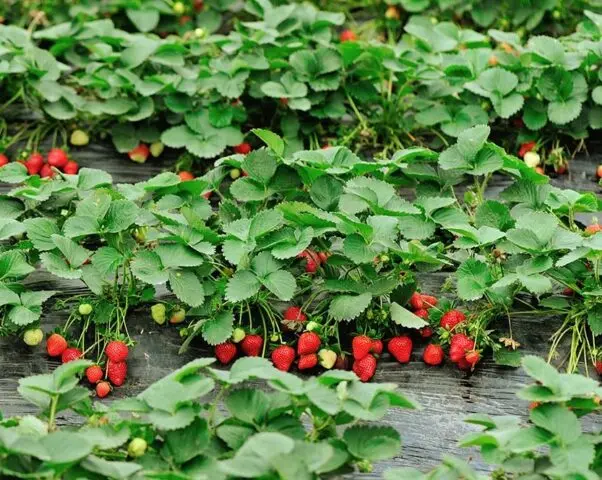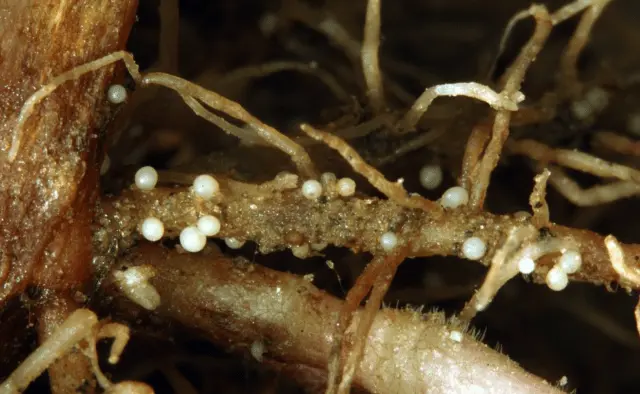Contents
The nematode on strawberries is a dangerous pest that can lead to the death of the entire bush and crop loss. It is a small worm that is difficult to see with the eye. It feeds on the juices of the plant and noticeably weakens it. If no action is taken, it quickly affects neighboring plantings and actively multiplies.
What does a nematode look like on strawberries with a photo
The nematode is a parasite that causes strawberry disease. This is a roundworm from the genus protostomes. There are several types of such pests, one of them is the leaf strawberry nematode. It is she who affects almost all varieties of strawberries, as well as many ornamental plants.
Appearance

The nematode has a thin, slender body
In length reaches from 1 to 20 mm, the color is white. Since the body is small, it is not always possible to visually detect a nematode on strawberries. The worm actively breeds in moderately warm conditions at a temperature of 18-20 degrees.
The nematode lays eggs that have an elongated oval shape, the diameter is narrow. Of these, larvae appear after a few days. They are markedly different from adults. The larvae are mobile, actively moving along the above-ground parts of the plant.
Danger
Nematodes are found almost everywhere. The pest is especially dangerous in the middle lane, regions of the North-West region, as well as in the North Caucasus. The nematode is voracious and very prolific. Up to 20 generations appear per season. They cause great harm to strawberries – the affected bushes can die. Even if they survive, part of the harvest will be lost.
Also, the danger of the nematode is due to the fact that the worms themselves are very small, so they are difficult to detect visually. Finally, because of the pest, the mustache is shortened. Therefore, it will no longer be possible to use them for propagating strawberries.
What do strawberry bushes look like, affected by a nematode
You can determine the nematode on strawberries by several signs:
- numerous swellings (galls) on leaves of different colors – reddish, yellowish-brown;
- loss of a layer of pubescence by petioles;
- the leaves become stiff, the surface wrinkles, turns dark green;
- the trunk dies;
- mustaches are shortened;
- sockets are deformed;
- fruits are small, not typical for this variety;
- apical buds wither;
- over time, the bush dies.
Nematodes parasitize not only on the leaves and stems, but also on the roots of strawberries. They feed on juices, quickly depleting the plant. As a result, the bush becomes dwarfed and dies, and the worms move to neighboring plantings.

Deformed berries due to nematode
Affected bushes become weak, first turn pale, then turn yellow, and finally turn black. At the same time, it is often impossible to determine to see the nematode with the naked eye. To reliably determine the presence of a pest, you can carry out the following tests:
- Dig up the affected strawberry bush and carefully examine the roots. If they have white growths, this clearly indicates a nematode infection.

- Grind the above-ground parts of the plant (foliage, flowers, shoots) and lower into the water. After 10 hours, you can look into the lens and see microscopic white worms.
Causes of strawberry infection
Strawberry nematodes can appear in any growing region. This is a dangerous pest, completely protected from which is unrealistic. It is worth remembering several factors that provoke the development of worms:
- moderately warm and humid weather (frequent rains);
- excess watering;
- too dense landings;
- lack of ventilation (in the case of growing strawberries in a greenhouse or in a greenhouse).
In most cases, it is possible to influence the appearance of a pest on strawberries. Particular attention is paid to planting in those seasons when there is unfavorable weather (a lot of rain).
How to get rid of nematodes on strawberries
There are many ways to treat strawberries on which a nematode has settled. Many gardeners suggest using folk remedies, but they are not effective in all cases. For the complete destruction of worms, it is necessary to use special preparations. It is also advisable to use agricultural practices – they are used for prevention.
Fighting nematodes on strawberries with chemicals
It is desirable to apply chemicals before the appearance of fruits. During fruiting, this is not recommended, except in cases of emergency. At the same time, it is important to observe the waiting time – the minimum number of days from the last processing to harvest.
Not all drugs are suitable for the extermination of worms. Among the most effective means are the following:
- “Heterophos” is a toxic compound that must be handled very carefully. The fruits can be harvested at least 45 days after the last spraying.
- “Phosfamide” is an effective solution, which is processed several times with an interval of 4-5 days.
- “Mercaptophos” – acts similarly to “Phosfamide”, can be used instead of it.
- “Ruskamin”, “Lindan” – means that give a good result only in the fight against adult nematodes. However, the eggs do not die after processing – over time, new larvae will hatch from them.
Therefore, it is necessary to carefully observe the dosage indicated in the instructions. During spraying, be sure to use a mask, gloves and other personal protective equipment.

Processing is carried out in the late evening, while the weather should be dry and calm
Fighting nematodes on strawberries with folk remedies
Folk remedies are used at the first detection of signs of an invasion. They show their effectiveness in case of regular use. Basically, summer residents recommend preparing such solutions, infusions or decoctions:
- Grind marigold flowers. Weigh 1 kg and pour 1 liter of water. Let stand for two days in a dark and cool place, strain and bring the volume to 10 liters.
- Take 1 kg of onion peel and insist in 10 liters of water for a day. Strawberries are processed weekly.
- Another proven recipe is an infusion of calendula (200 g of dried flowers per 5 liters of water at room temperature). You need to insist during the day in a warm room.
To do this, the affected strawberry bushes are dug up and placed in hot water with a temperature of + 47-50 degrees for 10-15 minutes. Then they are taken out and planted back.
Agrotechnical measures to combat the nematode
To combat the stem nematode on strawberries, agrotechnical methods are also used:
- For planting, you should buy only healthy seedlings from trusted suppliers. It is necessary to focus on the reputation of the company and customer reviews.
- First of all, it is necessary to dig up and destroy all plants affected by the nematode. The pest spreads quickly, so it is better to sacrifice 1-2 bushes than the entire bed.
- Do not cultivate strawberries in beds where infection has previously been observed. It is necessary to shed the soil with a weak solution of potassium permanganate and wait at least a year. Such a site must be carefully dug up in the fall.
- At the end of the season, cut off the leaves, flower stalks and take them as far as possible. Pests overwinter in the aerial parts of the plant, most often in the tissues of young shoots.
- Cultivation of varieties resistant to the nematode, for example, Slavutich and others.
Prevention
It will not be possible to completely eliminate the appearance of worms on the site, but it is possible to prevent their invasion. To do this, use the standard preventive measures:
- Plantings should not be too dense – depending on the variety, the bushes are planted at a distance of 20 or 30 cm.
- Watering is done regularly, but moderately. The surface layer of the soil should remain only slightly moist.
- Plant strawberries in the area where legumes, carrots, garlic, pumpkin, mustard or other green manure have grown for several years.
- Plant a flower border next to the garden bed from plants such as nasturtium, calendula and marigolds. They release phytoncides into the soil, which have a detrimental effect on the nematode.

Bushes should be periodically inspected to track the appearance of the first signs of damage.
Mistakes in the fight against strawberry nematode
Destroying the nematode to save strawberries is real. But beginners and even experienced gardeners often make mistakes that make it difficult to quickly deal with the pest. The most common are:
- Summer residents sometimes immediately treat the bushes with chemicals. In fact, this is an extreme measure, which can only be used occasionally.
- The use of folk remedies does not always give the desired result. If 2-3 treatments turned out to be ineffective, you should immediately spray the plantings with insecticides.
- Often gardeners choose the wrong place to plant. The site should be well lit and dry. Therefore, it is necessary to immediately exclude lowlands in which water stagnates after rains and abundant watering.
- Another common mistake is the use of the drug for several seasons. In fact, the nematode has time to form immunity, so you need to alternate one insecticide with another. The same applies to folk remedies for protection against worms.
Conclusion
The nematode on strawberries especially often appears in rainy, cloudy weather. Therefore, when growing, special attention should be paid to compliance with the norm of irrigation, ventilation of the greenhouse. If possible, it is better to choose those varieties of strawberries that are resistant to the pest.










